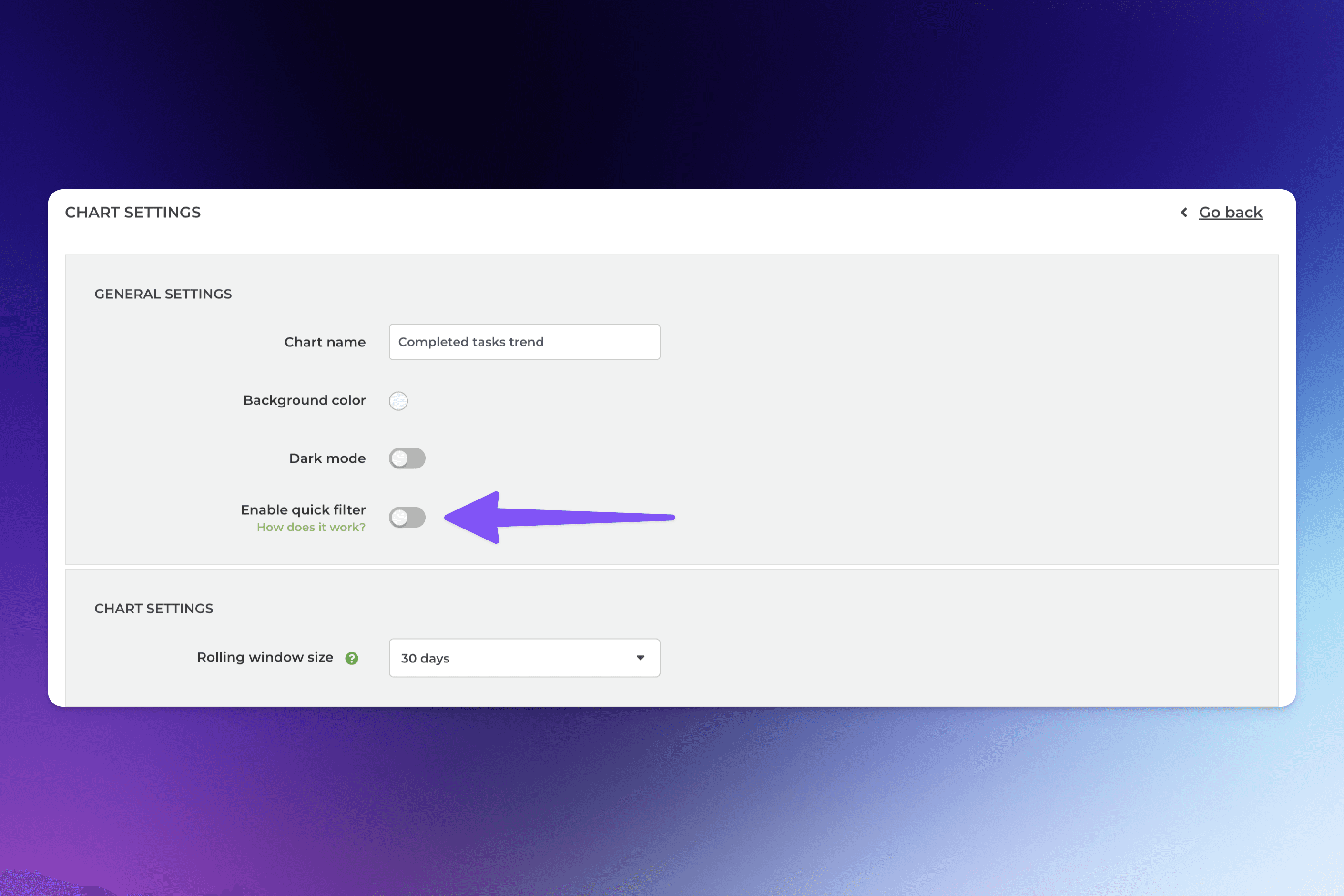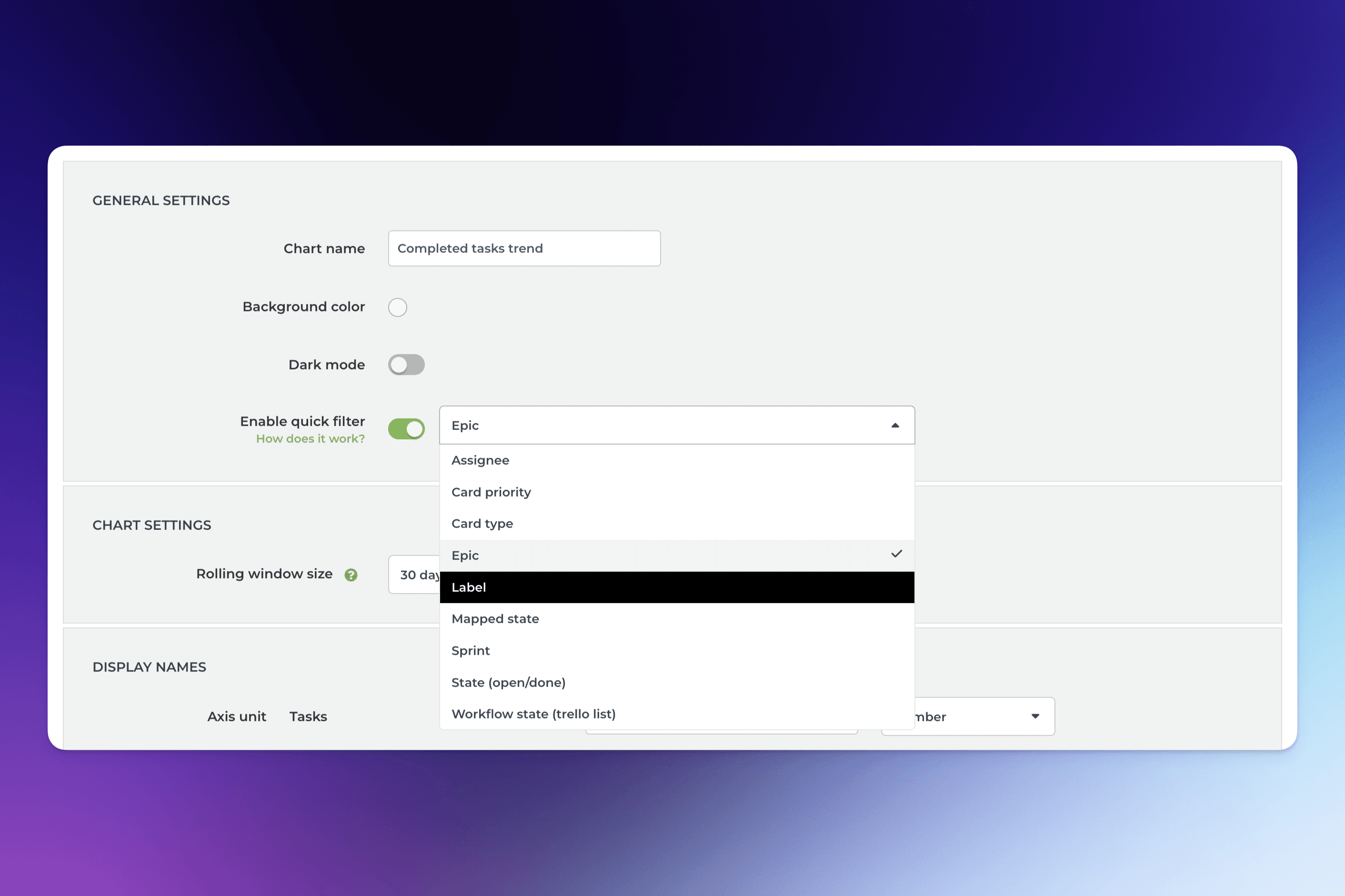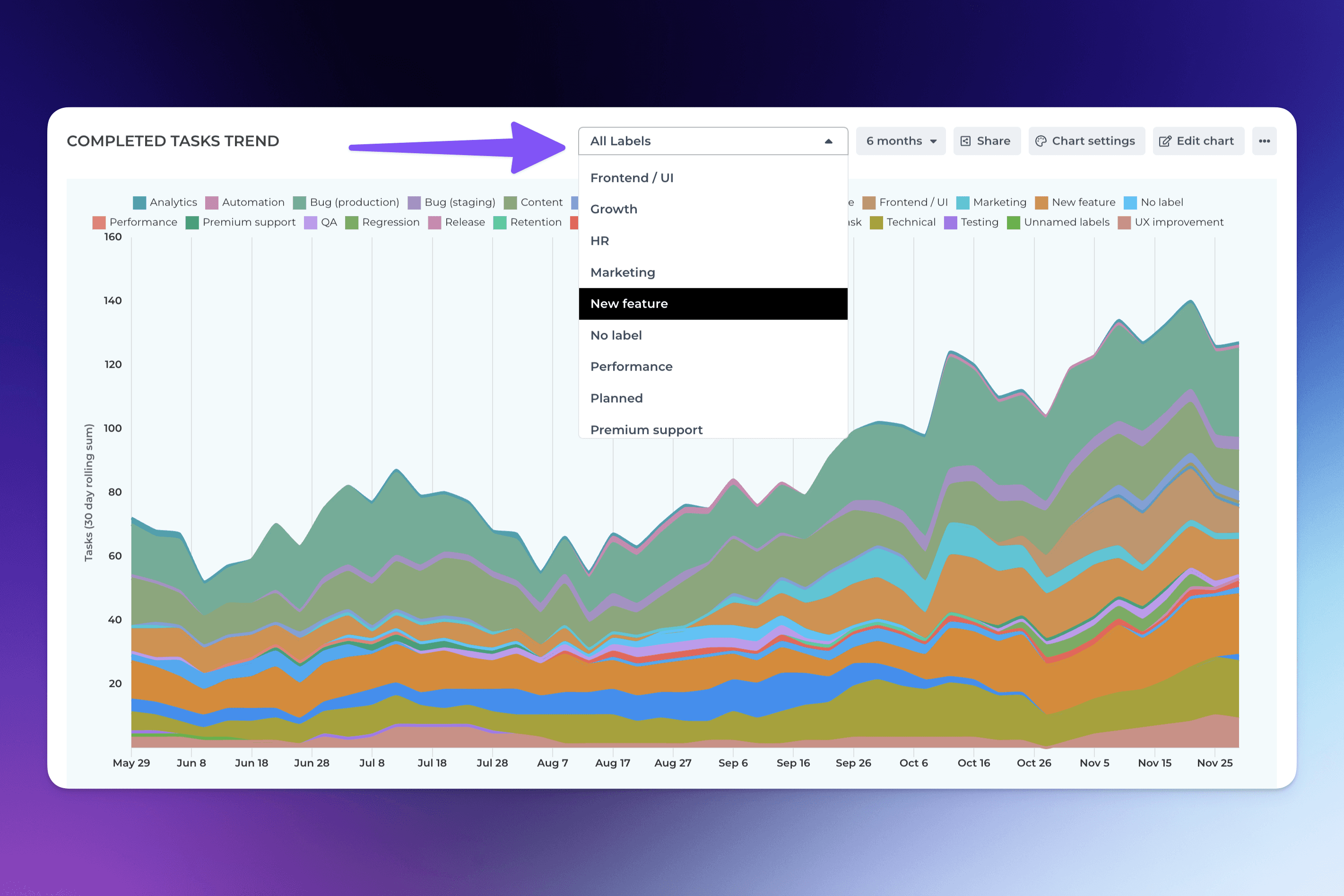Set a filter for a chart
Set a filter for a chart
Want to filter the contents of charts? We've got you covered since you can filter charts by any available property such as assignee or label. You can also filter by your custom fields. This guide teaches you how to use filters like a pro!
Want to filter the contents of charts? We've got you covered since you can filter charts by any available property such as assignee or label. You can also filter by your custom fields. This guide teaches you how to use filters like a pro!
Want to filter the contents of charts? We've got you covered since you can filter charts by any available property such as assignee or label. You can also filter by your custom fields. This guide teaches you how to use filters like a pro!
Guide contents:
Guide contents:
How to find the filter feature?
Each chart has its own filter. Therefore, to filter the contents of a report, you need to open an individual chart for editing, and then adjust the filter by clicking Set filter in the chart editor:

When you are editing a report under the Reports tab, you access the filter of an individual chart by clicking the Edit chart icon next to the three dots menu:

When you are in the Insights tab, you can filter all the charts at once by clicking the Set filter button on the top toolbar:

Note that when you set a filter in the Insights tab, it only affects what you see. Other users have their own filter.
When you click the Set filter button in any of those views, the same filter modal is shown:

In the filter modal, you can set filters such as label include “bug” or label does not include “bug”. You can also do more complex filters involving number comparisons, date comparisons, etc.
How to find the filter feature?
Each chart has its own filter. Therefore, to filter the contents of a report, you need to open an individual chart for editing, and then adjust the filter by clicking Set filter in the chart editor:

When you are editing a report under the Reports tab, you access the filter of an individual chart by clicking the Edit chart icon next to the three dots menu:

When you are in the Insights tab, you can filter all the charts at once by clicking the Set filter button on the top toolbar:

Note that when you set a filter in the Insights tab, it only affects what you see. Other users have their own filter.
When you click the Set filter button in any of those views, the same filter modal is shown:

In the filter modal, you can set filters such as label include “bug” or label does not include “bug”. You can also do more complex filters involving number comparisons, date comparisons, etc.
Filtering by assignee, label, board, project, etc.
You can filter by any of the task properties available in your data such as assignee, group, label, board, project, sprint, milestone etc.

The available filters depend on the data source. The common filter for all data sources include assignee, label/tag, data source, workflow state, and mapped state. Depending on the data source, you can also filter by project, section, group, sprint, epic, milestone, version etc.
You can set multiple filters by selecting them one by one. Each filter can have multiple options for is any of or is none of.
Once you have set the filters, click Save to apply the filter to the chart.
If you have added custom fields to your board, they will be automatically imported and made available for charts. When you create a custom chart, you can use the data in your custom field in filters.
Filtering by assignee, label, board, project, etc.
You can filter by any of the task properties available in your data such as assignee, group, label, board, project, sprint, milestone etc.

The available filters depend on the data source. The common filter for all data sources include assignee, label/tag, data source, workflow state, and mapped state. Depending on the data source, you can also filter by project, section, group, sprint, epic, milestone, version etc.
You can set multiple filters by selecting them one by one. Each filter can have multiple options for is any of or is none of.
Once you have set the filters, click Save to apply the filter to the chart.
If you have added custom fields to your board, they will be automatically imported and made available for charts. When you create a custom chart, you can use the data in your custom field in filters.
Filtering by number fields
You can filter charts by any of your number fields. You can find them in the filter window, and you can do comparisons such as is greater than or is less than:

You can also filter by exact match using is equal to or is not equal to:

You can also filter by which items have a value or do not have a value by selecting is empty or is not empty:

Filtering by number fields
You can filter charts by any of your number fields. You can find them in the filter window, and you can do comparisons such as is greater than or is less than:

You can also filter by exact match using is equal to or is not equal to:

You can also filter by which items have a value or do not have a value by selecting is empty or is not empty:

Filtering by date fields
Custom date fields can be used for filtering if they are mapped to either start date or due date. Once you have mapped your custom date field, and set a filter using start date or due date, it will be applied to your custom date field. Learn how to a map custom date field to a start or due date.
To set a filter by a date field, create a custom Task list chart and open the filter window by clicking Set filter:

For example, you can select Due date from the filter options and set it within the next 5 days:

You can set date comparison using either within the next or within the last x number of days. The resulting chart contains the items that meet that criteria. You can do that with any of your date fields.
Filtering by date fields
Custom date fields can be used for filtering if they are mapped to either start date or due date. Once you have mapped your custom date field, and set a filter using start date or due date, it will be applied to your custom date field. Learn how to a map custom date field to a start or due date.
To set a filter by a date field, create a custom Task list chart and open the filter window by clicking Set filter:

For example, you can select Due date from the filter options and set it within the next 5 days:

You can set date comparison using either within the next or within the last x number of days. The resulting chart contains the items that meet that criteria. You can do that with any of your date fields.
Filtering by text fields
You can add any of your text fields as columns to the Taks list. However, a lesser-known fact is that you can also use them for grouping and filtering data.

Before you can use your custom text fields in grouping and filtering, you need to map them as Group & filter first.
Filtering by text fields
You can add any of your text fields as columns to the Taks list. However, a lesser-known fact is that you can also use them for grouping and filtering data.

Before you can use your custom text fields in grouping and filtering, you need to map them as Group & filter first.
Filtering by substring
You can filter by partial text match using Contains or Doesn't contain. You can type the phrase in the filter window. It will be matched against the selected field, such as Label:

Selecting Label Contains "Bug", filters all the items that have the characters "Bug" as part of the label name. That would include labels susch as "Bug production" and "Bug staging".
Filtering by substring
You can filter by partial text match using Contains or Doesn't contain. You can type the phrase in the filter window. It will be matched against the selected field, such as Label:

Selecting Label Contains "Bug", filters all the items that have the characters "Bug" as part of the label name. That would include labels susch as "Bug production" and "Bug staging".
Filtering by task name
You can filter by the name of the item (issue/task/story, etc.) by selecting Item name from the filter menu.

You can enter the full name of the item, or use a substring of the name to include or exclude specific items from the set.
Filtering by task name
You can filter by the name of the item (issue/task/story, etc.) by selecting Item name from the filter menu.

You can enter the full name of the item, or use a substring of the name to include or exclude specific items from the set.
Applying AND/OR logic in filters
The filter logic depends on how you construct the filter conditions. In the simplest case, you just pick multiple options from the same menu:

In this case, the filter matches any item that has at least one of the selected options. In terms of logic, they are OR conditions, as it is sufficient if the resulting item contains only one of them.
You can also select multiple options by picking them one by one in separate menus:

In this case, the filter matches any item that has all the selected options. In terms of logic, they are AND conditions since the resulting items must contain all of them.
You can also combine both in the same filter. Here’s an example of a more complex filter including both AND and OR conditions:

The above filter would match all items that have label Automation, Content creation, or Documentation, and have Highest priority, and have not been completed yet.
Applying AND/OR logic in filters
The filter logic depends on how you construct the filter conditions. In the simplest case, you just pick multiple options from the same menu:

In this case, the filter matches any item that has at least one of the selected options. In terms of logic, they are OR conditions, as it is sufficient if the resulting item contains only one of them.
You can also select multiple options by picking them one by one in separate menus:

In this case, the filter matches any item that has all the selected options. In terms of logic, they are AND conditions since the resulting items must contain all of them.
You can also combine both in the same filter. Here’s an example of a more complex filter including both AND and OR conditions:

The above filter would match all items that have label Automation, Content creation, or Documentation, and have Highest priority, and have not been completed yet.
Configuring a quick filter
In the chart settings, you can configure a quick filter that will be shown on top of the chart. It allows adjusting the chart's content without accessing the chart editor.
In the chart settings, use the toggle to enable the quick filter:

Clicking the toggle reveals the filter options. These are the same options as what you have when setting a filter in the chart editor.

For example, selecting Label from the menu creates a quick filter for the label shown above the chart. The default selection is All labels, and you can filter the content by any available label by picking a label from the menu:

When you select filter criteria from the menu, the chart content is filtered by that selection. It allows quick comparisons between labels, iterations, departments, customers, or any other property you have in your data!
You can limit the number of options in a quick filter by setting the same filter inside the chart editor. The quick filter will contain only the items that are explicitly included in the filter
When you enable a quick filter for a chart, it will be present when the chart is shared with a link, embedded in a website, or added to a report.
Configuring a quick filter
In the chart settings, you can configure a quick filter that will be shown on top of the chart. It allows adjusting the chart's content without accessing the chart editor.
In the chart settings, use the toggle to enable the quick filter:

Clicking the toggle reveals the filter options. These are the same options as what you have when setting a filter in the chart editor.

For example, selecting Label from the menu creates a quick filter for the label shown above the chart. The default selection is All labels, and you can filter the content by any available label by picking a label from the menu:

When you select filter criteria from the menu, the chart content is filtered by that selection. It allows quick comparisons between labels, iterations, departments, customers, or any other property you have in your data!
You can limit the number of options in a quick filter by setting the same filter inside the chart editor. The quick filter will contain only the items that are explicitly included in the filter
When you enable a quick filter for a chart, it will be present when the chart is shared with a link, embedded in a website, or added to a report.